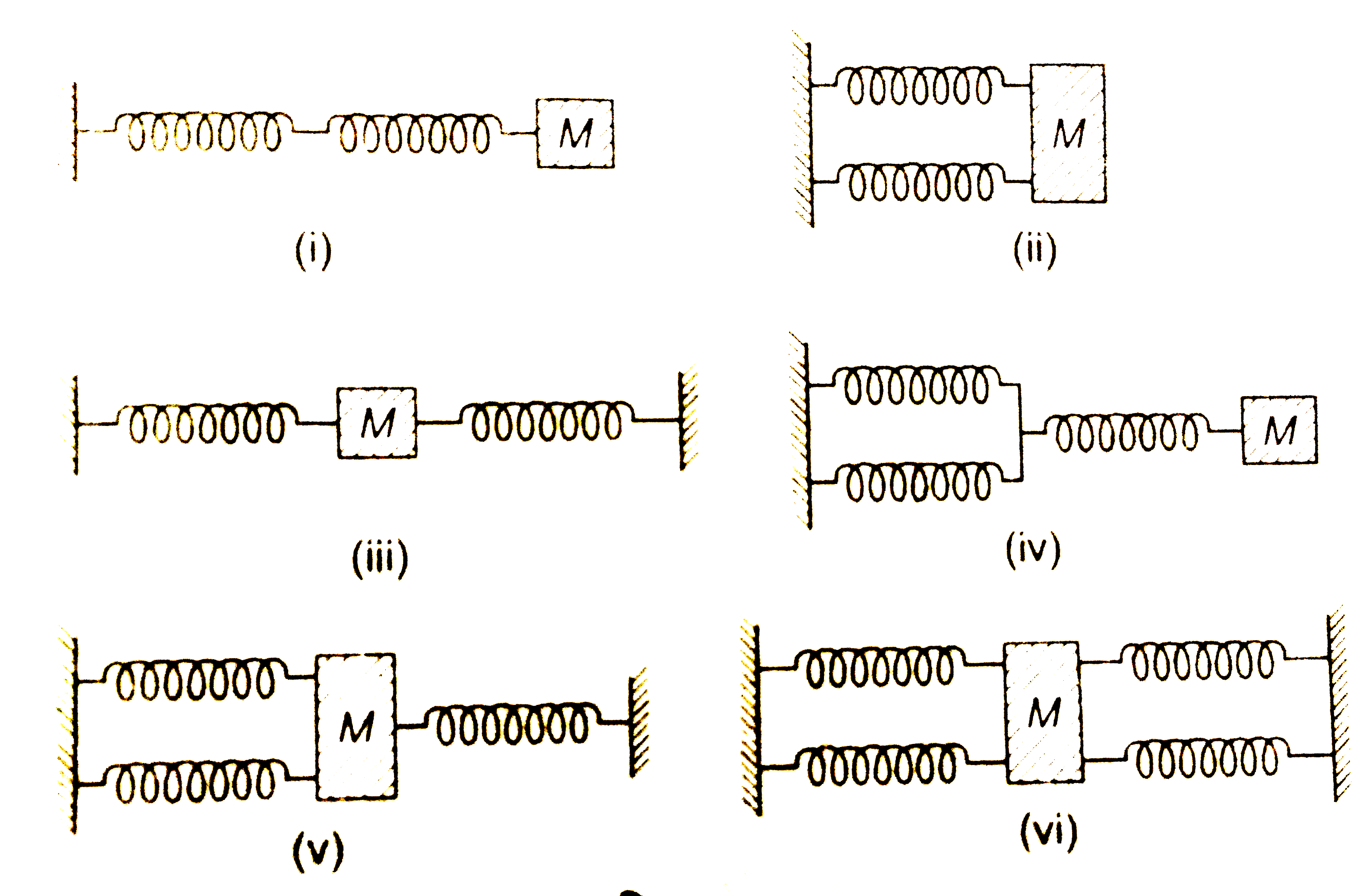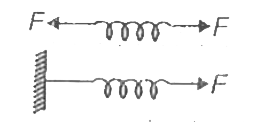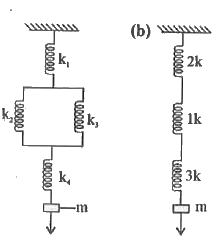Calculate the maximum extension of the spring in the following two cases. Also calculate period of oscillation in each case.
(a)  Solution in Kannada
Solution in Kannada
ma−ky
so that a=−kym and ya=∣∣∣−mk∣∣∣
Hence T=2π√ya may be written as T=2π√mk
Maximum extension of the spring will be .y.
(b) ma=−2ky

so that ya=∣∣∣−m2k∣∣∣ Altermaivelyμa=−kywhere μ=m1m2m1+m2=m2
&T=2π√ya ∴ma2=−kyor ma =−2ky
T=2π√m2k ma=−k(2y)
Maximum extension of the spring will be .2y..
Topper's Solved these Questions
- BOOK - SUBHASH PUBLICATIONCHAPTER - OSCILLATIONSEXERCISE - FIVE MARKS QUESTIONS WITH ANSWERS4videos
OSCILLATIONS
- BOOK - SUBHASH PUBLICATIONCHAPTER - MOTION IN PLANEEXERCISE - NUMERICALS WITH SOLUTIONS47videos
MOTION IN PLANE
- BOOK - SUBHASH PUBLICATIONCHAPTER - PHYSICAL WORLDEXERCISE - TWO MARKS QUESTIONS WITH ANSWERS30videos
PHYSICAL WORLD
Similar Questions
Arrive an expression for time period of simple pendulum.
01:28View SolutionTwo forces 8N and 5N are acting at a point on a body at an angle 120∘ then find the (i) magnitude and (ii) direction of their resultant.
09:25View SolutionMathematics is the language of physics. Justify the statement.
03:45View SolutionFind the time period of the oscillation of mass m in figure a,b,c what is the equivalent spring constant of the pair oif springs in each case?
 03:26View Solution
03:26View SolutionExplain the oscillations of a loaded spring and find the realtions for the time period and frequency in case of (i) horizontal spring (ii) vertical spring.
02:18View Solutionspring of force constant k clamped rigidly at onoe end and a mass m attached to its free end. A force F applied at the free end stretches the spring. Figure shows the same spring with both ends free and attached to a mass m at either end. Each end of the spring in figure is stretched by the same force F.
(a) What is the maximum extension of the spring in the two cases ?
(b) If the mass in figure and the two masses in figure are released free, what is the period of oscillation in each case?
 02:09View Solution
02:09View SolutionIn which case there is maximum extension in the wire, if same force is applied on each wire
11:22View SolutionTwo identical springs, each of spring factor k, may be connected in the following ways. Deduce the spring factor of the oscillation of the body in each case.
03:09View SolutionCalculate the combined resistance in each case:
 04:18View Solution
04:18View Solutionचित्र 24.49 में प्रत्येक स्प्रिंग का बल नियतांक k है । प्रत्येक स्थिति में द्रव्यमान M के दोलन का आवर्तकाल क्या होगा ?
 03:23View Solution
03:23View SolutionFigure shows tow cases. In first case a spring (spring constant K) is pulled by two equal and opposite forces F at both ends and in second case is pulled by a force F at one end. Extensions (x) in the springs will be
 02:49View Solution
02:49View SolutionCalculate the effective spring constant in each case and hence write the expression for period of oscillation. Ignore the masses of the spring.
 02:24View Solution
02:24View SolutionFigure a) shows a spring of force constant k clamped rigidly at once end and a mass m attached to its free end. A force F applied at the free end stretches the spring. Figure b) shows the same spring with both ends free and attached to a mass m at either end. Each end of the spring in figure is stretched by the same force F.
(a) What is the maximum extension of the spring in the two cases ?
(b) If the mass in figure and the two masses in figure are released free, what is the period of oscillation in each case?
 View Solution
View SolutionFigure 14.26 (a) shows a spring of force constant k clamped rigidly at one end and a mass m attached to its free end. A force F applied at the free end stretches the spring. Figure 14.26 (b) shows the same spring with both ends free and attached to a mass m at either end. Each end of the spring in Fig. 14.26(b) is stretched by the same force F.

What is the maximum extension of the spring in the two cases ?View SolutionFind the time period of the oscillation of mass m in figure a,b,c what is the equivalent spring constant of the pair oif springs in each case?
 View Solution
View Solution

